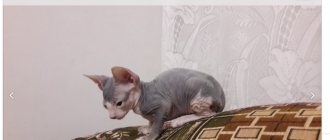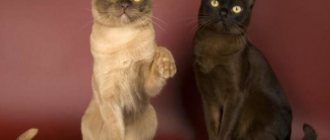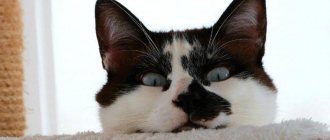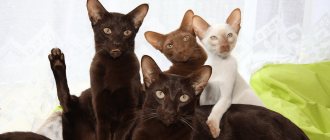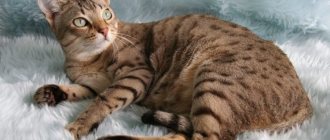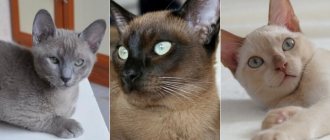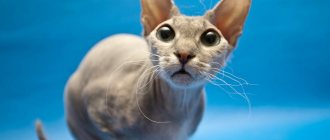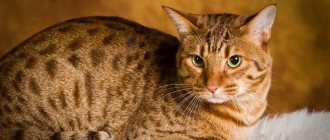The Peterbald is an elegant hairless cat with expressive almond-shaped eyes and large ears. The impressive appearance of the sphinx from the banks of the Neva allows one to compare it with the creation of a sculptor, and its loving disposition and high intelligence contribute to its popularity among those who dream of an unusual pet.
To understand who the Peterbald is suitable for, let’s look at the specifics of this breed.
Brief history of the breed
The Peterbald is a very young breed of cat. The breed is the result of targeted selection work by St. Petersburg resident Olga Mironova. Orientals and the Don sphinxes took part in its formation. The first such kittens were born in 1994 as a result of planned outcrossing.
Peterbald very quickly acquired official status and recognition from leading felinological organizations. It was registered by TICA in 1997. And 6 years later, Peterbald cats received recognition from the WCF. And although the St. Petersburg Sphynxes have official registration and standard, breeders still care about the extreme nature of their exterior.
According to professionals, the appearance of cats of this breed should be as close as possible to the Siamese-Oriental type.
Mating of Peterbalds
The main thing to consider before breeding Peterbalds is that you cannot breed completely hairless cats with cats of the same type. A very common result of such a union can be the appearance of offspring with serious pathologies. It is optimal that one of the parents is bald and the other has brush or velor fur.
A female cat must be in two heats before she can go on a “date” with a male cat. The ideal time for mating is approximately one and a half years old. A sign of the onset of heat is the animal's excessive affection - the cat begins to rub against everything, and when you pet it, it purrs, arches its back and trembles. The cat will help you understand whether the mating time has been chosen correctly - he will either immediately show readiness for affection, filling the room with a loud meow, or, if the kitty arrived early, he may leave altogether. The result can only be achieved after several matings.
All existing standards allow crossing Peterbalds with Orientals and Siamese breeds; mating with Balinese and Javanese is also allowed.
If both parents are Peterbalds, then there is a high probability of completely hairless or flocked kittens appearing in the litter. When mating the St. Petersburg Sphynx and Oriental cats, cubs with skin type flock, brush or straight-haired may appear.
Interesting Facts
During the short period of existence of the St. Petersburg sphinxes, many interesting things were associated with them:
- The name of the breed translated from English means “bald Peter”.
- Despite the lack of a rich coat, the Peterbald is not a hypoallergenic cat. His saliva contains the same amount of Fel D1 protein as other breeds.
- For its elastic, slightly sticky skin, the hairless St. Petersburg Sphynx received the nicknames “gummy” and “elastic”.
Peterbald diseases
With proper and regular care, timely vaccination and deworming, these animals do not experience any special health problems. Due to the characteristics of the skin, the Peterbald may develop an allergic rash, which can be combated with the help of a regular anti-acne lotion, Salicylic ointment or Zenerite.
Hairless animals should not be overcooled to avoid colds and respiratory problems. That is why many owners buy warm clothes for their pets and allow them to sleep under the blanket with them.
Peterbalds love to climb into bed and sleep next to a person.
In Peterbalds whose skin has a tortoiseshell, blue and cream color, gum hyperplasia can be observed. Surgery will help stop the development of pathology. Regular care will help to avoid inflammation of the eyes and ears.
The most dangerous pathology of Peterbalds is the underdevelopment of the thymus, the gland responsible for the development of all systems and protective functions of the body. This disease in all cases ends in the death of the animal.
Breed description, standards, appearance
The Peterbald is an elegant, graceful cat with long legs and a thin, whip-like tail. A more detailed description of the breed is presented in the WCF standard, developed in 2003.
Dimensions and weight
Petersburg Sphynxes are medium-sized cats. The height of the breed is 23-30 cm at the withers, and the body length from the nose to the tip of the tail reaches 80-95 cm.
The weight of an adult Peterbald cat rarely exceeds 5 kg. The cat's weight is about 3 kg.
Anatomical characteristics
A purebred St. Petersburg Sphynx must meet the following description:
- The head is wedge-shaped with a slightly convex profile, flat forehead and high cheekbones.
- The ears are large and wide at the base.
- The eyes are almond-shaped, slanted. The iris is colored blue, green or yellow.
- The body is of medium size, moderately elongated, with developed muscles and an elegant neck.
- The limbs are thin, long, with oval paws and flexible toes.
- The tail has a pointed tip and visually resembles a whip.
Color and coat type
The body of the Peterbald is covered with soft skin, gathering in numerous folds. There are more of them on the head, less on the body. The Peterbald inherited from the Donchak a gene responsible for the absence of fur. That’s why the classic St. Petersburg Sphynx is a hairless cat. He is never fluffy or long-haired.
In some cases, there are areas of fur on the cat’s body.
Peterbald has 2 types of color:
- oriental (tortoiseshell, bicolor, tabby, red, chocolate, cream, black and blue);
- color point (tabby, blue, tortie, chocolate, lilac, red, seal and cream point).
Possible breed defects
Flaws in appearance, in the presence of which the Peterbald will not receive a high mark for its exterior:
- twisted forelimbs;
- excessively light frame;
- absence of skin folds on the head.
Pedigree varieties
Depending on the presence and structure of the coat, St. Petersburg Sphynxes are divided into several varieties:
- Hairless. Completely hairless cats with skin that feels like thin rubber.
- Flock. This Peterbald has no mustache or eyebrows. The cat's body is covered with silky hair, the length of which does not exceed 2 mm.
- Velours. The kitten has short hair on its body, which disappears as it grows. In general, the velor Peterbald has a thicker coat than the flocked Sphynx. And on the cat’s paws there are furry “socks”.
- Brush. This type of Peterbald is partially or completely covered with crimped hair. As a cat gets older, it is common for a cat's back and neck to become bald.
- Brush point. The tail, paws and muzzle of this St. Petersburg Sphynx are covered with thick, coarse hair. The body of a brush point cat can be hairless or with a delicate flock.
In addition to the above varieties, there is a straight-haired variety in the breed. This Peterbald does not have the hairless gene. He has a regular straight mustache and a classic fur coat. The straight-haired Peterbald is less expensive than the hairless, but is not considered a Plembrace.
Important! St. Petersburg Sphynxes have intermediate types of coat, such as velor point or flock point. As the cat matures, they may transform into other varieties. This complicates the choice of a kitten and makes it difficult to determine exactly what the Peterbald will look like in the future.
Character and temperament
Peterbalds are friendly and playful cats. The loving St. Petersburg Sphynxes easily find a common language with all family members, but they single out one owner for themselves, to whom they feel a special affection. They do not harbor grudges and do not have the habit of doing dirty tricks on the sly.
The curious nature of the St. Petersburg Sphynx does not allow him to sit still. An inquisitive cat will try to explore all corners of the home and penetrate even closed doors.
On a note. Peterbalds are very sociable creatures. Cats of this breed not only purr and meow, but also make many other sounds. St. Petersburg sphinxes especially love “intimate conversations” with their adored owner.
Breed and children
The Peterbald Sphynx has a patient and accommodating disposition. He is sympathetic to children's pranks and rarely uses his claws.
Breed and other animals
Sociable and non-conflict St. Petersburg sphinxes get along well not only with their relatives, but also with peace-loving dogs.
How to choose the right kitten
To buy a purebred Peterbald, you need to contact trusted breeders or a nursery. Babies must be at least 12 weeks old at the time of sale. It is important that they have documents confirming their breed and vaccinations.
It is better to choose a Peterbald kitten not by photos and videos, but in person. This way it will be possible to evaluate the conditions in which the baby is kept and observe how he behaves in a familiar environment. The kitten should be curious, cheerful and not shy.
A healthy little Peterbald has a soft belly, clear eyes, clean ears and soft-touch skin without scratching, rashes or redness. It is important that the kitten does not have an unpleasant odor from the mouth and dirt under the tail. It is also worth paying attention to the presence of hernias and inflammation on the gums.
Kitten care
Competent breeders separate small St. Petersburg Sphynx cats from their mothers no earlier than they are 3 months old. By this age, kittens are already feeding on their own, know how to use a scratching post, and are litter box trained. Therefore, the owners of the small St. Petersburg Sphynx can only show the pet where its bowls, tray and place to sleep are located, and wait until it adapts to the new conditions.
In order not to expose the kitten to unnecessary stress, at first it is fed what it is accustomed to from the breeder. New products are introduced into the diet of the St. Petersburg Sphynx gradually, carefully monitoring the reaction of his body. The feeding regimen depends on the age of the animal:
- up to 3 months – 5 times a day;
- 3-6 months – 4 times a day;
- from 6 months – 3 times a day.
To protect a curious kitten, household chemicals, wires, indoor plants and fragile objects are hidden from him. Since the Peterbald has a habit of exploring everything around and can climb inside an open washing machine, before turning it on, you must always check if there is a restless pet there.
Mating and choosing a kitten
Since the St. Petersburg Sphynx breed is quite young, such animals are just beginning to gain popularity. In Russia there are only a few nurseries that breed such cats. The average cost of a kitten is from 5 to 15 thousand rubles. Kittens that fully comply with the standard and exhibition norms are more expensive - from 35 to 50 thousand rubles.
Breeders advise taking kittens away from their mother no earlier than 3 months. If you do this earlier, the kitten will have a hard time being separated from its mother, which will negatively affect its health.
Since the Peterbald is a rare breed, difficulties with mating are inevitable. If the owner plans to breed the breed in the future, it is recommended to keep in touch with the breeder, who will help find a good partner. Before mating, the cat must be treated for worms and make sure there are no other diseases.
Care and maintenance of an adult cat
The Peterbald is a heat-loving cat that is not capable of living outside. Like other Sphynxes, she loves walks in the fresh air. But before leaving the house, it is advisable to put on clothes.
In winter, overalls will protect the cat from the cold; in summer, a light blanket will protect the delicate skin of the Peterbald from drying out and burns. And in order for the Sphinx to look neat, it is taught hygiene from an early age:
- Peterbald is prone to excessive tearing. Therefore, the eyes of a cat of this breed are wiped daily with a clean cloth moistened with boiled water.
- The ears of the St. Petersburg Sphynx are treated 1-2 times a week with cotton pads moistened with a special lotion.
- The cat's growing claws are periodically shortened with a nail clipper, trying to act very carefully so as not to injure living tissue.
- The teeth of the St. Petersburg Sphynx are regularly cleaned with a silicone brush and non-foaming paste. This simple procedure will help get rid of plaque and prevent the formation of stones.
- The Peterbald's skin is covered with a special lubricant produced by sweat glands. An excess of this substance is fraught with the development of dermatological diseases, so it is regularly removed with a cotton pad with a small amount of baby cosmetic oil.
On a note. Experts do not recommend bathing Peterbalds using shampoos. After all, even the mildest detergents can provoke the development of allergies.
Feeding the cat
Peterbald is a cat with accelerated metabolic processes. Therefore, he is not picky about food and has an excellent appetite.
With an industrial type of nutrition, St. Petersburg Sphynxes buy premium or super-premium products, which contain all the required vitamins and minerals.
Cats of this breed eat the following brands of food best:
- Farmina;
- Bosch;
- Gemon;
- Brit Care.
With a natural type of nutrition, the Peterbald is fed mainly with fresh, lean meat. Also included in the menu of cats of this breed:
- porridge with water;
- eggs;
- offal;
- boiled vegetables;
- sea fish;
- dairy products.
It is strictly forbidden to feed the St. Petersburg Sphynx with river fish, bones, sweets, baked goods, sausages, smoked meats and pickles. The menu of a cat of this breed should not contain fried, fatty and spicy foods, as well as leftovers from the owner’s table.
What to feed the St. Petersburg Sphynx?
St. Petersburg Sphynxes are very picky about their diet. Improper nutrition immediately affects the appearance of animals - the skin begins to intensively secrete a brown substance. This is the first sign that you urgently need to change your menu.
And the appetite of these cats is simply amazing. Due to the fact that animals do not have thick fur and have a high body temperature, their metabolism is also accelerated. Basically, the Peterbald can eat anything you offer. Therefore, it is important to control your diet. It is best to give preference to premium and super-premium food. Moreover, today many manufacturers produce specialized food specifically for Sphinxes, which is also ideal for Peterbalds.
If you want to feed your cat natural food, include in your pet's diet:
- lean meats;
- sea fish;
- boiled vegetables;
- porridge.
Education and physical activity
The Peterbald is a highly intelligent and quick-witted cat that is easy to train. If desired, he can be taught simple commands and fetching. True, it is better to conduct classes in the form of a game, without forcing the pet to do anything against its will.
St. Petersburg Sphynxes are quite active and love to jump. They climb tall cabinets without problems, but do not have a habit of destruction. So that the Peterbald can throw out the accumulated energy, he is equipped with a play complex and is periodically asked to run after a laser pointer.
Pet diseases
You need to keep an eye on your pet's tan. Short sunbathing will do him good. But everything should be in moderation. Otherwise, the cat will get burned.
In addition, there are other diseases. For example, gum hyperplasia and underdevelopment of the thymus gland may occur (the organ is responsible for the development of the pet’s entire body). Skin and respiratory ailments are common. Average life expectancy is 14 years.
Peterbald - St. Petersburg Sphynx. This breed is distinguished by sophistication and grace. These are charming pets that everyone in the house will love. They also treat people well, as they are friendly and sociable.
Vaccinations and antiparasitic treatment
To prevent viral and infectious diseases, the St. Petersburg Sphynx is regularly vaccinated with a complex drug that promotes the development of stable immunity:
- to rhinotracheitis;
- calcivirus;
- panleukopenia.
The first vaccination for a Peterbald kitten is given at the age of 7-8 weeks. After 4 weeks, the pet is revaccinated with the same drug, but with an anti-rabies component. In the future, the cat is vaccinated annually.
To protect the St. Petersburg Sphynx from diseases transmitted by helminths, he is systematically given appropriate medications. Antihelminthic treatment is carried out 2 times a year with mandatory repetition after 10-14 days.
Health
The modern St. Petersburg Sphynx has good health and a well-developed immune system. When communicating with other animals or while walking, Peterbalds can contract a dangerous viral infection. It is important to follow the vaccination schedule:
- At 8-12 weeks, a comprehensive vaccination against panleukopenia, rhinotracheitis and calcivirosis is given.
- After changing teeth, the vaccine is re-administered in combination with an anti-rabies drug.
- Every next 12 months it is worth revaccinating and deworming.
The drugs “Narvak”, “Merial” and “Intervet” are considered high-quality products. The choice should be left to the treating veterinarian and not to vaccinate yourself.
Pros and cons of the breed
Like any other cat breed, the Peterbald is endowed with both positive and negative qualities:
| pros | Minuses |
| Attractive exotic appearance | The need for careful skin care |
| No shedding | Loud voice and excessive talkativeness |
| Good-natured and playful disposition |
St. Petersburg Sphynxes are unique cats with a sophisticated, refined appearance and amiable disposition. They are suitable for confident and active people who have the opportunity to allocate enough time to communicate with and care for their pet.
Horoscope compatibility
St. Petersburg sphinxes are suitable for people born under the sign of Aries. Cats are connected with humans by sociability, active behavior and a thirst for action. The rich timbre of the voice and the tendency to talk will appeal to this sign. All differences in cats related to the head are considered evidence of a connection with Aries. Therefore, all cats of the eastern or oriental group are suitable for the sign.
The Peterbald is also suitable for Scorpios, but not so much by its character as due to its unusual coat. The more exotic the type of coat an animal has, the more similarities it has with this sign.
The youngest Sphynx Peterbald is a promising breed that is suitable for active, self-confident people. The incredible combination of playfulness and affection is no less attractive than the exotic appearance. By paying due attention to the care and maintenance of the pet, the family will receive a truly grateful and faithful companion.
